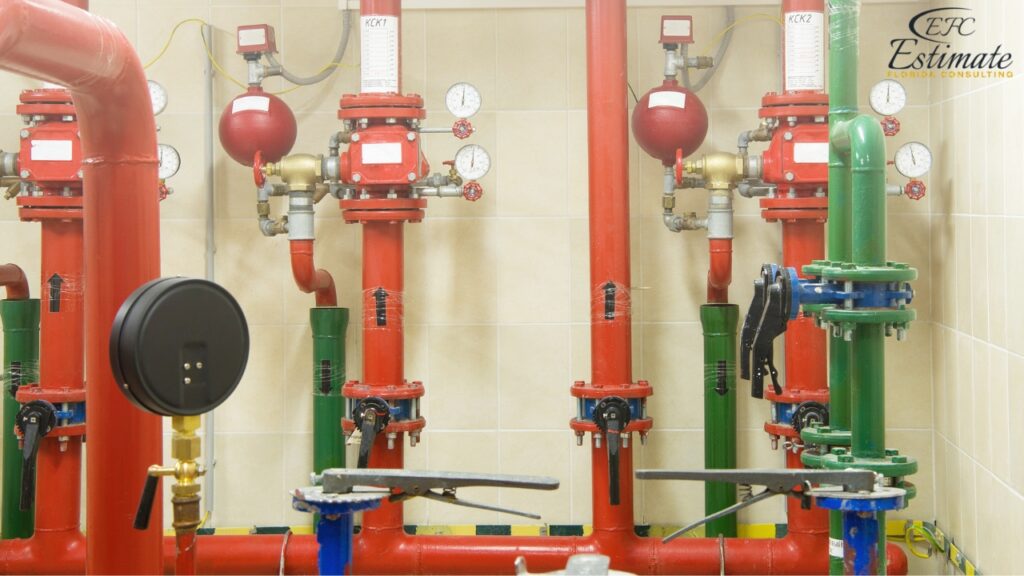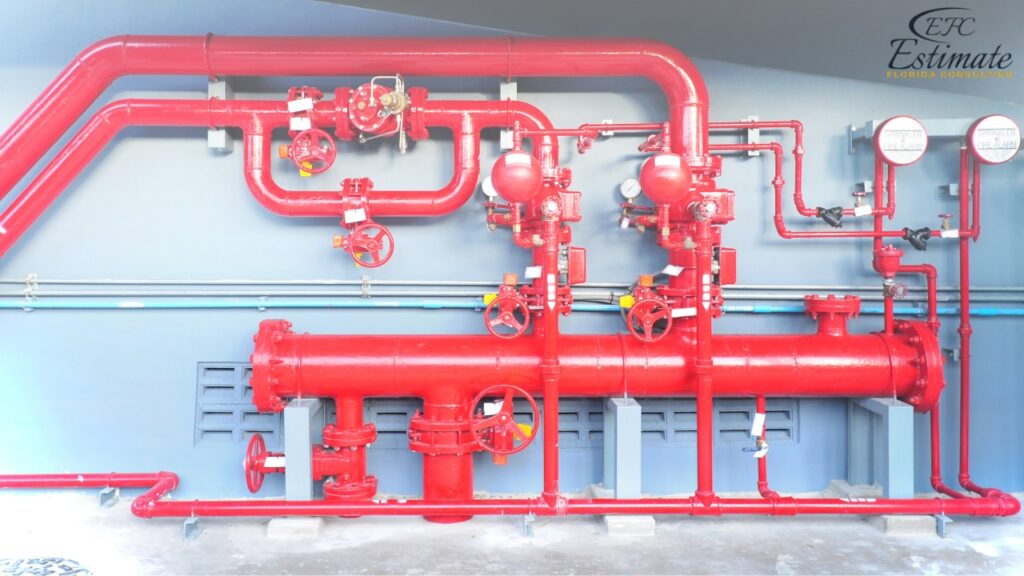How Much Does a Warehouse Fire Sprinkler System Cost?
A warehouse fire sprinkler system typically costs between $500,000 and $964,000, translating to $2 to $4 per square foot for a 250,000 sq ft warehouse. This total cost includes materials, labor, design, permits, and installation. Lower-end costs cover basic systems with standard components, while higher-end costs involve advanced systems with premium materials, complex designs, and additional features like monitoring and alarm integration. Factors influencing the cost per square foot include the warehouse’s size and layout, local labor rates, and specific code requirements. Proper planning and budgeting for unforeseen expenses are essential to ensure the project stays within the estimated cost range.

Cost Breakdown for Installing a Warehouse Fire Sprinkler System
Material Costs
The cost of materials for a warehouse fire sprinkler system can vary widely based on the type, quality, and brand of the components. Here’s a detailed breakdown of typical material costs:
Material Type | Estimated Cost per Sq Ft | Total Cost for 50,000 Sq Ft Warehouse |
Wet Pipe Sprinkler System | $2.60 – $5.20 | $130,000 – $260,000 |
Dry Pipe Sprinkler System | $3.90 – $6.50 | $195,000 – $325,000 |
Pre-Action Sprinkler System | $4.50 – $7.80 | $225,000 – $390,000 |
Deluge Sprinkler System | $5.20 – $9.10 | $260,000 – $455,000 |
The type of system chosen directly impacts the cost due to differences in complexity and the required materials. For example, wet pipe systems are more straightforward, hence less costly, while deluge systems require more sophisticated components, resulting in higher costs. Each system type offers different benefits suited to specific needs, influencing the overall budget based on the chosen system’s features and capabilities.
Labor Costs
Labor costs for installing a warehouse fire sprinkler system can vary depending on the complexity of the project, the type of system, and the region. Here’s an estimate of labor costs:
Labor Task | Estimated Cost per Sq Ft | Total Cost for 50,000 Sq Ft Warehouse |
System Design and Engineering | $0.65 – $1.30 | $32,500 – $65,000 |
Installation | $3.90 – $6.50 | $195,000 – $325,000 |
Testing and Commissioning | $0.90 – $1.60 | $45,000 – $80,000 |
Labor costs can be substantial, especially for larger warehouses or more complex systems. These costs cover various aspects, from the initial design and engineering to the actual installation and final testing and commissioning. Skilled labor is required to ensure the system is installed correctly and functions as intended, preventing future issues and ensuring compliance with safety standards.
Get 5 New Leads Next 7Days With Our System
- Multi-Family Building
- Hotel Building
- Hospital Building
- Warehouse Building
- High-Rise Building
- Shopping Complex
Additional Costs
Additional costs can include permits, inspections, maintenance contracts, and any custom features or finishes. Here’s an estimate of these costs:
Additional Component | Estimated Cost |
Permits and Inspections | $32,500 – $65,000 |
Maintenance Contracts | $13,000 – $32,500 per year |
Custom Features and Upgrades | $32,500 – $97,500 |
Miscellaneous Expenses | $19,500 – $39,000 |
Permits and inspections are mandatory to ensure that the installation complies with local building codes and safety regulations. Maintenance contracts are essential to keep the system operational and extend its lifespan, involving regular inspections and necessary repairs. Custom features might include advanced control systems or specialized sprinkler heads tailored to specific needs. Miscellaneous expenses cover unexpected costs that might arise during the installation process.
Factors Affecting Fire Sprinkler System Costs
Building Size and Layout
The size and layout of your warehouse significantly impact the overall cost of installing a fire sprinkler system. Larger warehouses require more materials and labor, while complex layouts may need additional piping and sprinkler heads to ensure adequate coverage. The height of the warehouse also affects the type of sprinkler heads and installation techniques used. Detailed planning and accurate layout designs are crucial to ensure comprehensive coverage and efficient use of resources.
Local Building Codes and Regulations
Local building codes and fire safety regulations can impact the cost of installing a fire sprinkler system. Some areas may have more stringent requirements, necessitating additional components or higher installation standards. It’s important to consult with local authorities and ensure your system complies with all relevant regulations to avoid fines or legal issues. Staying updated on local codes ensures that the installation process runs smoothly and that the system meets all legal requirements.
Water Supply and Pressure Requirements
The availability and pressure of the building’s water supply can influence the cost of installing a fire sprinkler system. Buildings with inadequate water pressure may require additional equipment, such as booster pumps or water storage tanks, to ensure the system operates effectively. Upgrading the water supply infrastructure can add significant costs to the project. Ensuring a reliable and adequate water supply is essential for the optimal performance of the fire sprinkler system.

Retrofit vs. New Construction
Installing a fire sprinkler system in an existing warehouse (retrofit) can be more expensive than installing one in new construction. Retrofitting involves additional challenges, such as accessing existing structures, rerouting utilities, and minimizing disruption to warehouse operations. These factors can increase labor costs and extend the installation timeline. New construction allows for easier integration of the sprinkler system into the overall design, often resulting in lower installation costs and fewer complications.
Cost Comparison by Warehouse Size
The size of your warehouse significantly impacts the overall cost of installing a fire sprinkler system. Here’s a cost breakdown for different warehouse sizes using a wet pipe sprinkler system:
Warehouse Size (Sq Ft) | Total Material Cost | Total Labor Cost | Additional Costs | Total Cost |
10,000 | $26,000 – $52,000 | $54,500 – $94,000 | $19,500 – $46,800 | $100,000 – $192,800 |
20,000 | $52,000 – $104,000 | $109,000 – $188,000 | $39,000 – $93,600 | $200,000 – $386,600 |
50,000 | $130,000 – $260,000 | $272,500 – $470,000 | $97,500 – $234,000 | $500,000 – $964,000 |
100,000 | $260,000 – $520,000 | $545,000 – $940,000 | $195,000 – $468,000 | $1,000,000 – $1,928,000 |
The cost increases proportionally with the size of the warehouse, as larger spaces require more extensive systems to ensure comprehensive coverage. Each increase in size brings a corresponding rise in both material and labor costs, as well as additional expenses to ensure the system meets all safety standards and operates efficiently. Larger warehouses might also face unique challenges that can further impact the overall cost.
Cost-Saving Tips
Here are some tips to help you save on fire sprinkler system costs:
Obtain Multiple Quotes
Getting multiple quotes from different contractors can help you find the best price for your project. Be sure to compare not only the overall cost but also the scope of work and the quality of materials being offered. This approach can also help you negotiate better terms and identify the most reliable contractors. Comparing multiple quotes ensures you get the best value for your investment, avoiding overpaying for services.
Plan for Off-Season Installation
Scheduling your fire sprinkler system installation during the off-season can sometimes result in lower labor costs. Contractors may offer discounts during slower periods to keep their crews busy. Off-season installation can also lead to quicker project completion, as contractors typically have more availability. Planning for off-season work can save costs and expedite the installation process, making it a strategic choice for budget-conscious projects.
Choose Cost-Effective Materials
While high-end materials offer many benefits, choosing more affordable options for certain components can help reduce costs. Consider your budget and the long-term maintenance requirements when selecting materials. Opting for cost-effective materials doesn’t mean compromising on quality, as many affordable options still provide excellent durability and performance. Balancing cost and quality ensures that you get the best return on investment without sacrificing the effectiveness of the fire sprinkler system.
Do Some Work Yourself
If you have the skills and time, doing some of the preliminary work, such as clearing the installation area or preparing the site, can help reduce labor costs. However, be sure to leave the actual system installation to the professionals to ensure it is done correctly. Taking on simpler tasks yourself can significantly cut costs, while professional installers handle the more complex and critical aspects of the system.
Download Template For Fire Safety Project Breakdown
- Materials list updated to the zip code
- Fast delivery
- Data base of general contractors and sub-contractors
- Local estimators

Conclusion
Installing a fire sprinkler system in a warehouse is a significant investment that can greatly enhance the safety, property protection, and regulatory compliance of your facility. Understanding the various costs involved, including materials, labor, and additional expenses, can help you plan your project effectively and ensure it stays within budget. By considering the benefits of different sprinkler system options and the associated costs, warehouse owners can make informed decisions that best suit their needs and preferences. Proper planning and budgeting can help avoid unexpected expenses and ensure a successful installation. Investing in high-quality materials and skilled labor will result in a reliable, effective fire sprinkler system that provides peace of mind and enhanced safety for your warehouse. By prioritizing fire safety, you not only protect valuable assets and inventory but also ensure the well-being of your workforce and compliance with local regulations.
FAQs
Installing a fire sprinkler system in a warehouse typically costs between $500,000 and $964,000 for a 250,000 sq ft space. This translates to $2 to $4 per square foot and includes materials, labor, design, permits, and installation.
Costs are influenced by the warehouse’s size and layout, local labor rates, specific code requirements, and the complexity of the system chosen. Advanced systems with premium materials and additional features like monitoring and alarm integration can also increase costs.
Larger warehouses require more materials and labor, while complex layouts may need additional piping and sprinkler heads for adequate coverage. Detailed planning ensures comprehensive coverage and efficient use of resources.
Local codes and regulations may necessitate additional components or higher installation standards, affecting overall costs. Compliance ensures legal operation and meets safety standards.
Retrofitting an existing warehouse is generally more expensive due to additional challenges like accessing existing structures and rerouting utilities. New construction allows for easier integration and often results in lower installation costs.
Google Reviews



Process To Get Warehouse Fire Sprinkler System Cost Estimate Report
Here I am going to share some steps to get warehouse fire sprinkler system cost estimate report.
-
You need to send your plan to us.
You can send us your plan on info@estimatorflorida.com
-
You receive a quote for your project.
Before starting your project, we send you a quote for your service. That quote will have detailed information about your project. Here you will get information about the size, difficulty, complexity and bid date when determining pricing.
-
Get Estimate Report
Our team will takeoff and estimate your project. When we deliver you’ll receive a PDF and an Excel file of your estimate. We can also offer construction lead generation services for the jobs you’d like to pursue further.

